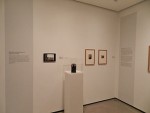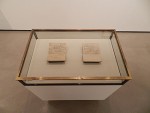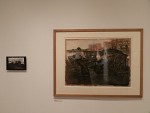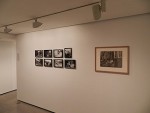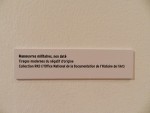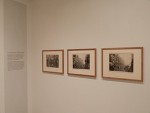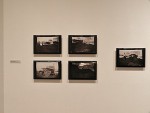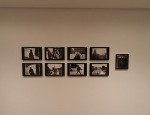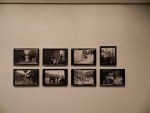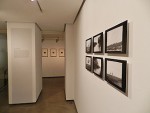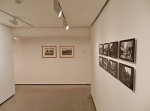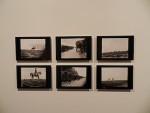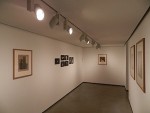The browser will either open the file, download it, or display a dialog.
George Hendrik Breitner: Pioneer of Street Photography
Institut Néerlandais (Dutch Institute), Paris
November 3, 2011 – January 22, 2012
Publications:
Hans Rooseboom,
George Hendrik Breitner: The Photographer.
Online publication at the Dutch Institute for Art History Website (RKD), http://breitnerenglish.rkdmonographs.nl/, 2011.
Hans Rooseboom,
George Hendrik Breitner: Pioneer of Street Photography [booklet].
Paris: Dutch Institute, 2011.
13 pp; 13 b/w illustrations
€ 3
George Hendrik Breitner (1857–1923), a daring Dutch artist from the late nineteenth century, aimed at pushing Dutch impressionism from the idealized countryside to the busy streets of Amsterdam. Born and briefly artistically trained in Rotterdam, Breitner left for The Hague in 1876 to learn from the artists of The Hague School. But it was his contact with Vincent van Gogh that encouraged his taste for the “people,” the working class in its daily activity. In addition to this, he became associated with the avant-garde group called the Tachtigers (Eighteen-Eighties Artists), which promoted a new writing style, between realism and impressionism. The combination of these influences and teachings led him to create highly personal works, in both subject matter and style. Breitner also embraced photographic techniques as an aid for his paintings and as an art form in itself, becoming a pioneer impressionist photographer in the late-nineteenth-century Netherlands.
The exhibition of George Hendrik Breitner's work at the Institut Néerlandais in Paris was dedicated to his photographs. Organized in ten sections within seven rooms, the show displayed a selection of Breitner's photographic work (1889–1915) with around 150 black and white pictures hanging on white walls. Curator Hans Rooseboom wanted to show Breitner's urban photography, as well as the conservative and modernist facets that he identifies in the artist’s work. The title, Pioneer of Street Photography, encompassed these several aspects of his pictures. Although the sections “Portraits, Genre and Nudes” and “Horses” did not explicitly depict the city, the other eight sections displayed diverse views of Amsterdam, its old town, the canals, its construction sites, and its pedestrian strollers. Taking place on the occasion of the 2011 Paris Photo fair, the exhibition resulted from a collaboration between the RKD (Netherlands Institute for Art History, home to three-quarters of the approximately 2,850 remaining negatives and prints) and the Rijksmuseum.[1] Thanks to the combined efforts of these two institutions, the Parisian host venue, and the exhibition and catalog entitled Snapshot at the Van Gogh Museum, Breitner's photographic work was internationally launched this year.
The first room was intended as an introduction to the artist's way of working. In addition to the photographs, the visitor found one of Breitner's cameras and one painting. The show's first section “Painting Case and Photographic Camera” opened with a photograph of a working site in Amsterdam with an artist-case left on a chair. As the wall text of this section explained, Breitner rarely went out without his working tools, a fact that was confirmed by the presence of the open artist-case that can be seen in the photograph (fig. 1). Even more, Rooseboom states that Breitner sometimes took several cameras with him to obtain different results. Thus, the artist was likely fully equipped when wandering the streets of Amsterdam in search of inspirational material.[2] Also on display was one 1888 Kodak camera conveniently showcased, and some sketchbooks rendering quick notes on the cityscape (fig. 2). Moreover, the photograph of Workers Carrying a Wagon at the Jacob van Lennepkade also appeared replicated as a watercolor, both pieces hanging next to each other (fig. 3). A preparatory sketch at the City Archive of Amsterdam elucidates the process of replicating this picture by dividing the photographic image into squares that were later projected on a bigger surface in order to enlarge the original image. This piece could not be shown in Paris due to its current fragile state, as the curator puts it.[3]
Having seen the “backstage” of Breitner's work, the visitor was then surrounded by photographs displayed in the style of a contemporary art gallery. When the pictures were original framed prints, such as those from the Rijksmuseum, they were hung in a horizontal line; when they where modern prints made from original negatives from the RKD, they were assembled in groups, with both types of pictures hanging relatively far away from their labels (fig. 4). The show represented a brief survey of Breitner's photography, not only in the number of photographs displayed, but also in the amount of information provided. Note, for instance, the minimal character of the wall-labels, announcing only the title of the picture, the date, the material, and the current location (fig. 5). Due to this, the result was ineffective in general, especially considering the range of literature published on Breitner, although the design of an exhibition for a foreign audience not familiar with the artist might explain an aesthetic, rather than a more informative, choice.[4]
Breitner's production was paradoxically defined by curator Rosseboom as both conservative and modernist. Conservatism appeared in Breitner's choice for the “intimate ‘old city’[5] (fig. 6). As Rooseboom explains:
The city of Amsterdam changed dramatically in the period after he moved there in 1886, yet we see very little of these developments represented in his photographs. [There were] great new building projects [. . .] which had such a distinctive presence that it must have been a deliberate choice by Breitner not to picture them.[6]
It is the very fact that Breitner focused on the demolition of the old buildings and the building sites themselves rather than on the newly finished modern constructions that leads Rooseboom to state Breitner's conservatism (fig. 7). Furthermore, although Breitner was very interested in horses and horse trams, he was clearly less enchanted with the electric trams that appeared around 1900, calling them “ugly, soulless boxes” and avoiding them too.[7] Conservatism, thus, should be understood in the choice of an idealized view of Amsterdam, with the old city as the subject matter. Whether the preference for this subject matter denotes a conservative character in Breitner's work remains arguable. The scholar Griselda Pollock, for example, affirms Breitner's innovative practice when he “zoomed in on details in order to observe the strange and unpredictable character of urban encounters or the disjointedness of a terrain undergoing economic transformation.”[8] According to Pollock, however, the construction site pictures should be seen more as a celebration of the changing reality that resulted from the modern city, rather than as a trace of the photographer's conservative taste for ruins.
Breitner's modernity clearly emerged in his technical skills and visual sensitivity. He mastered the snapshot-like photograph, the fragmented view, and the silhouette effect with back-lit objects. All these techniques were unfamiliar in Breitner's period and especially his use of the latter would make Breitner's work definitely modern in agreement with Rooseboom.[9] To illustrate this, the section on modernism offered the viewer a selection of nine pictures showing the aforementioned characteristics in scenes of people in motion (fig. 8). This fact seems not coincidental, as the photographer needed the movement of the figures to achieve the snapshot qualities. Therefore, in the section devoted to “The Strollers” similar effects could be observed (fig. 9). The series devoted to the military exercises was richly represented, displaying a great range of technical experimentation as Breitner played with zooming in and out around the figures, capturing them in motion and silhouetting them against a variety of settings (figs. 10–12). Their presence in the show highlighted the emphasis on rhythm, seriality, and balance in the photographs, as when the artist photographed a row of horses arranged in line or centered the figure of a cavalry soldier in an almost perfectly balanced composition. These images added even more sophistication to the already modern photographs by Breitner.
Human portraits and nudes appeared in the show depicting Breitner's most intimate photographic production. Breitner's wife, Marie Jordan, posed both with and without clothes in the privacy of their home (fig. 13). Many other faces have been identified in these domestic photographs, making it clear that Breitner profited from family gatherings to take pictures of his relatives or acquaintances in relaxed attitudes.[10] Several other faces, however, remain unknown. These figures were most likely models posing for Breitner as if they were engaged in their daily routines. For instance one series of photographs document this, where two young women appear alone or together in a terrace behind a house, both still, dancing, and walking fast.[11] Indeed, seriality was a key aspect of Breitner's work. In contrast to impressionist artists who started painting in series, such as Claude Monet in his Waterlilies, seriality meant something more practical for Breitner. Rooseboom explains that the artist organized his negatives in envelopes with topographic notes or references such as “horses against light.” “That Breitner grouped his negatives this way indicates that he regarded them as a sample collection.”[12] The samples thus constituted one of his painting tools, used when he composed images by combining the photographic samples in order to execute paintings that replicated his “collages.”[13]
George Hendrik Breitner: Pioneer of Street Photography was a delicately designed, but slight show. It clearly sought to captivate an audience unfamiliar with this artist's work. And it did so by presenting elementary information to the visitor, but most importantly, beautiful pictures in a neutral setting. With simple white walls and the black and white photographs artistically arranged, the visitor could really feel the hectic movement in the street scenes or the peacefulness of the lonely canals. With this exhibition, Breitner was exported out of the Netherlands and presented to a wider audience. The show displayed his series of Amsterdam's pictures focusing on pedestrians, building sites, women—both on the street and naked in his studio—, and his series of horses, providing a representative sense of his photographic work. However, more in depth information could have been given. Aspects such as the controversial conservatism or modernity of the pictures or the seriality of his work were only briefly addressed. Overall, the show succeeded in crowning Breitner as one of the most groundbreaking, late nineteenth- and early-twentieth photographers, and granted him a special position in the canon of modernist photography.
Alba Campo Rosillo, MA
Art Historian
info[at]albacampo.com
[1] For more information about the provenance of the photographic collection, see Hans Rooseboom, “De wasmand van Breitner/Breitner’s Laundry Basket,” RKD Bulletin 3 (1997): 11–20.
[2] Hans Rooseboom, “Movement Studies in an Urban Setting: The Photographs of George Hendrik Breitner” in Snapshot, Painters and Photography, 1888–1915, Elizabeth W. Easton, ed., exh. cat. (New Haven and London: Yale University Press, 2011), 84.
[3] Hans Rooseboom, “RE: Recensie,” e-mail to the author, April 10, 2012.
[4] There are approximately130 sources about George Hendrik Breitner. The literature is listed on the RKD database (scroll down to see the literature list).
[5] Hans Rooseboom, "Between tradition and modernism," in George Hendrik Breitner. The Photographer. Rijksdienst voor Kunsthistorische Documentatie (Nov. 1, 2011): http://breitnerenglish.rkdmonographs.nl/between-tradition-and-modernism
[6] Ibid.
[7] Rieta Bergsma and Paul Hefting, eds., George Hendrik Breitner, 1857–1923. Schilderijen, tekeningen, foto's. (Bussum, Netherlands: Thoth, 1994), 182; “. . . [L]eelijke, ziellooze dozen” quoted in Rooseboom, “Between tradition and modernism,” see endnote 9.
[8] Griselda Pollock, “The Cities and Countries of Modernity: Van Gogh among his Dutch Contemporaries,” in Art in the Age of Van Gogh, exh. cat. (Toronto: Art Gallery of Ontario, 1998), 53.
[9] Hans Rooseboom, “Between tradition and modernism”: http://breitnerenglish.rkdmonographs.nl/between-tradition-and-modernism
[10] The photo series made by Breitner at his appartment at 227 Overtoom Street in Amsterdam (between 6/25/1901 and 5/5/1903) gives a good idea of the aforementioned: Double-portrait possibly with Lise Jordan, Group-portrait with Lise Jordan and Two Ladies, Portrait of Maria Margaretha Breitner. To see more images of this photo series, check the mother record at the RKD dabatase.
[11] The following photo series is of several girls in a snow-covered garden: Portrait of Two Girls in the Snow, Portrait of Two Girls in the Snow (2), Portrait of Two Girls in the Snow (3), Portrait of Two Girls in the Snow (4), Portrait of Two Girls in the Snow (5), Portrait of Two Girls in the Snow (6), Two Young Women in the Snow, Two Young Women in the Snow (2), Portrait of Geesje Kwak, Portrait of Geesje Kwak (2).
[12] Hans Rooseboom, “Movement Studies in an Urban Setting: The Photographs of George Hendrik Breitner,” 86.
[13] To see the paintings resulting from the collage of pictures shown in note 11, click on the following links: Three Ladies in the Snow, Ladies in the Snow or Neighbours' Talk, Two Ladies in the Snow or Street Types, Two Ladies at the Street and Girls in the Snow.


